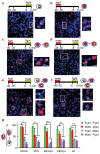Functional identification of an aggression locus in the mouse hypothalamus
- PMID: 21307935
- PMCID: PMC3075820
- DOI: 10.1038/nature09736
Functional identification of an aggression locus in the mouse hypothalamus
Abstract
Electrical stimulation of certain hypothalamic regions in cats and rodents can elicit attack behaviour, but the exact location of relevant cells within these regions, their requirement for naturally occurring aggression and their relationship to mating circuits have not been clear. Genetic methods for neural circuit manipulation in mice provide a potentially powerful approach to this problem, but brain-stimulation-evoked aggression has never been demonstrated in this species. Here we show that optogenetic, but not electrical, stimulation of neurons in the ventromedial hypothalamus, ventrolateral subdivision (VMHvl) causes male mice to attack both females and inanimate objects, as well as males. Pharmacogenetic silencing of VMHvl reversibly inhibits inter-male aggression. Immediate early gene analysis and single unit recordings from VMHvl during social interactions reveal overlapping but distinct neuronal subpopulations involved in fighting and mating. Neurons activated during attack are inhibited during mating, suggesting a potential neural substrate for competition between these opponent social behaviours.
Figures





Comment in
-
Animal behaviour: the nexus of sex and violence.Nature. 2011 Feb 10;470(7333):179-81. doi: 10.1038/470179a. Nature. 2011. PMID: 21307926 No abstract available.
-
Behaviour: All's fair in love and war.Nat Rev Neurosci. 2011 Apr;12(4):186. doi: 10.1038/nrn3015. Epub 2011 Mar 16. Nat Rev Neurosci. 2011. PMID: 21562499 No abstract available.
References
-
- Tinbergen N. The study of instinct. xii. Clarendon Press/Oxford University Press; 1951.
-
- Hess WR. Stammganglien-Reizversuche. Berichte der gesamten. Physiologie. 1928;42
-
- Hess WR, Brügger M. Das subkortikale Zentrum der affecktiven Abwehr-reaktion. Helv. Physiol. Acta. 1943;I:33–52.
-
- Hrabovszky E, et al. Neurochemical characterization of hypothalamic neurons involved in attack behavior: glutamatergic dominance and co-expression of thyrotropin-releasing hormone in a subset of glutamatergic neurons. Neuroscience. 2005;133:657–666. - PubMed
-
- Kruk MR, et al. Discriminant analysis of the localization of aggression-inducing electrode placements in the hypothalamus of male rats. Brain Res. 1983;260:61–79. doi:0006-8993(83)90764-3 [pii] - PubMed
Publication types
MeSH terms
Grants and funding
LinkOut - more resources
Full Text Sources
Other Literature Sources
Miscellaneous

